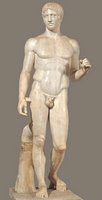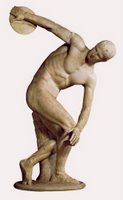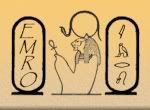
This is a very interesting article about the depiction of the male nude over time and context. The two best points made by the author of this commentary are 1) that the Greeks made the body (particularly the male--in the democratic, yet, un-egalitarian culture) a philosophy; and 2) that the body as depicted by Greeks is primarily intellectual and secondarily sexual; the order switches when personal style is introduced. "Greek athletes are abstract," says the author, Jonathan Jones. This is certainly a compelling point.
Jones discusses the comedic quality of Canova's statue of Napoleon in the
 Apsley House--it is both sexual and absurd. Then he takes us through ancient Greece, the Renaissance, the Baroque, and all the way up to modern fashion ads by Calvin Klein and Dolce & Gabbana. Polykleitos's famed canon of male proportions are highly intellectual and abstract; and, even though the character is muscular and nude, sexuality is secondary. Simply by the act of
Apsley House--it is both sexual and absurd. Then he takes us through ancient Greece, the Renaissance, the Baroque, and all the way up to modern fashion ads by Calvin Klein and Dolce & Gabbana. Polykleitos's famed canon of male proportions are highly intellectual and abstract; and, even though the character is muscular and nude, sexuality is secondary. Simply by the act of  creating a "canon," almost all stylistic sexuality is dissolved. He points how Leonardo da Vinci's "Vitruvian Man" is cosmological and not sexual.
creating a "canon," almost all stylistic sexuality is dissolved. He points how Leonardo da Vinci's "Vitruvian Man" is cosmological and not sexual.Caravaggio was no idealist. He showed people warts and all, and was not afraid of showing them in an unflattering light (no pun intended). Jones states that Caravaggio's Bacchus is clearly marked with the artist's style, thus sexualizing it. A statuesque figure of a street
 urchin becomes fleshy and real in form and in context/content and connotatively tactile and sensual. In Caravaggio's Deposition, "the nude has b
urchin becomes fleshy and real in form and in context/content and connotatively tactile and sensual. In Caravaggio's Deposition, "the nude has b ecome unheroic, pitiful, and human." Donatello's David reeks with stylized sexuality. "David wears leg armour that sets off his nudity. His buttocks are emphasized. The bronze of an adolescent, hand on hip, huge sword in his hand, is mounted on marble and you walk right around him, painfully aware of the sensuality of the polished metal." Jones also argues that Church's denunciation of nudity during the Renaissance and Baroque periods only made the works more sexual/sensual (forbidden fruit).
ecome unheroic, pitiful, and human." Donatello's David reeks with stylized sexuality. "David wears leg armour that sets off his nudity. His buttocks are emphasized. The bronze of an adolescent, hand on hip, huge sword in his hand, is mounted on marble and you walk right around him, painfully aware of the sensuality of the polished metal." Jones also argues that Church's denunciation of nudity during the Renaissance and Baroque periods only made the works more sexual/sensual (forbidden fruit).
The ancient Greek masculine figure was a mathematical and philosophical construction--almost too cerebral to be erotic. The figures were regular, systematic, and abstract with "crisp idealism." What actually confronts the viewer's feelings about sexuality (their own in particular) is an artist's particular style, not the nudity itself. This might not seem like a new idea, but Jones elucidates it in a humorous and intelligent way.
Other images mentioned in Jones's commentary....
© Stephanie Lewis, 2006








1 comment:
good article .shall wait for more.
rgds
Post a Comment